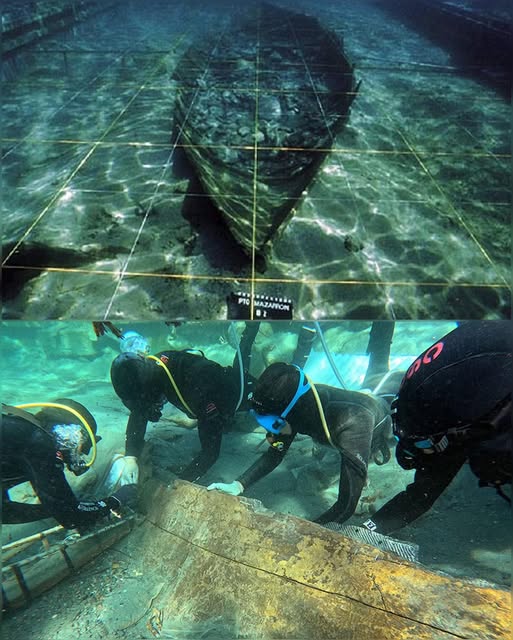
They called it a “time capsule,” sealed not in bronze or stone, but in the stillness of the Black Sea. Lying nearly two kilometers beneath the surface, this merchant ship had not felt the warmth of the sun for over 2,400 years. Now, with lights from a submersible casting eerie glows across its weathered planks and coiled ropes, the past breathed again—silent, salt-preserved, and astonishingly whole.
Discovered in 2018 off the coast of Bulgaria, this Greek trading vessel is the oldest intact shipwreck ever found. Archaeologists date it back to around 400 BCE, the classical period of ancient Greece—a time when Herodotus was writing histories and the Parthenon had just been built. And yet, there it was, resting in pristine form on the seabed, mast still upright, hull unbroken, amphorae still nestled in its hold. It is a relic not just of an era, but of human ambition: of trade, exploration, and the ever-present gamble of venturing into the unknown.
What makes this ship so astonishing isn’t just its age. It is its preservation. The Black Sea’s lower depths are anoxic—lacking oxygen. That means bacteria and marine organisms that would normally consume wood are absent. Time, in this part of the world, is slowed by chemistry. The ropes are still knotted. The planks, though warped by pressure, remain in their original form. Even the steering oar rests in place, as if waiting for a ghostly hand to guide it once more.
To understand the ship’s story, one must imagine a different world—one of ancient mariners and city-states, where the sea was both a highway and a hazard. The Aegean and Black Seas were critical arteries of commerce. Greek traders sailed north through the Bosphorus into the Black Sea, dealing in grain, wine, olive oil, and luxury goods. This vessel, with its unmistakably Hellenic design, likely carried amphorae filled with such cargoes—perhaps wine from Chios or oil from Attica—destined for the colonies along the Crimean coast or the Thracian hinterlands.
It would have been manned by a small crew, perhaps a dozen sailors, each hardened by salt and storm. Their lives were governed by the whims of weather and the fragility of wooden hulls. A sudden squall, a navigation error, or an unseen rock could bring doom within moments. And yet they sailed, again and again, weaving the economic and cultural fabric of the ancient world.
Was this ship caught in a storm? Did it founder in rough waters, or perhaps take on water after striking a submerged reef? No human remains have been found—only cargo and the ship itself, perfectly preserved but eerily empty. Whatever happened, it sank swiftly, settling upright on the seabed like a sleeping leviathan.
What stirs the heart most about this shipwreck is not just what it tells us about trade or technology, but what it whispers about human experience. This was not merely a vessel. It was a floating home, a workplace, a pᴀssage between worlds. Somewhere, long ago, families waited on shore for news that never came. Merchants waited for goods that would never arrive. Stories were lost—until now.
To look upon this ship is to look into the soul of our ancestors. Their hopes, their labor, their daring—all crystallized beneath layers of silt and silence. And yet, in this silence, there is music: the poetry of resilience, of craftsmanship, of life paused mid-breath and preserved by the cold embrace of the deep.
In a time when history is so often a collection of fragments—a shard here, a coin there—this ship is a rarity: complete, whole, almost defiant in its refusal to decay. It offers scholars a Rosetta Stone of seafaring, shipbuilding, and maritime life in antiquity. But beyond scholars, it touches something deeper in all of us: a sense of wonder, a connection to the universal voyage we all share.
Isn’t that what history is, in the end? A sunken ship in the ocean of time—lost for a while, but never truly gone.
Would you step aboard, if you could?



